Carbohydrate Study guides, Class notes & Summaries
Looking for the best study guides, study notes and summaries about Carbohydrate? On this page you'll find 16792 study documents about Carbohydrate.
All 16.792 results
Sort by
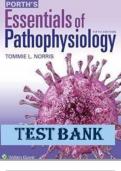
-
Porth’s Essentials Of Pathophysiology 5th Edition Test Bank with Rationales | Complete Guide A+
- Exam (elaborations) • 600 pages • 2023
-
- $24.99
- 21x sold
- + learn more
Porth’s Essentials Of Pathophysiology 5th Edition Test Bank 1. Chapter 1 Although the basic structure of the cell plasma membrane is formed by a lipid bilayer, most of the specific membrane functions are carried out by: A) Bound and transmembrane proteins B) Complex, long carbohydrate chains C) Surface antigens and hormone receptors D) A gating system of selective ion channels Ans: A Feedback: The functions of plasma membrane depend on the presence of proteins that are bound in the lipid bilay...
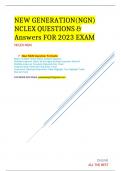 Popular
Popular
-
NEW GENERATION(NGN) NCLEX QUESTIONS & Answers FOR 2023 EXAM
- Exam (elaborations) • 91 pages • 2023 Popular
-
- $25.49
- 11x sold
- + learn more
NEW GENERATION(NGN) NCLEX QUESTIONS & Answers FOR 2023 EXAM All Answers are correct. All the Best! The New Gen Nclex has 150 questions 1. A nurse is caring for a patient with diabetes. Which of the following actions should the nurse take when administering insulin? Select all that apply. A. Verify the correct dose with another nurse. B. Administer insulin via intramuscular injection. C. Monitor the patient's blood glucose level. D. Check the expiration date of the insuli...
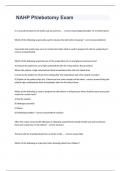
-
NAHP Phlebotomy Exam 2023 with 100% correct answers
- Exam (elaborations) • 24 pages • 2023
-
Available in package deal
-
- $17.99
- 3x sold
- + learn more
In a normal hematocrit, the buffy coat accounts for... - correct answerApproximately 1% of whole blood Which of the following is generally used to cleanse the skin before drawing? - correct answerAlcohol Inaccurate test results may occur in certain test when what is used to prepare the skin to venipunture? - correct answerAlcohol Which of the following would be part of the preparation for an oral glucose tolerance test? A) Instruct the patient to eat a high-carbohydrate diet for 3 days...

-
Test Bank for Williams' Basic Nutrition & Diet Therapy 16th Edition by Staci Nix McIntosh ISBN 9780323653763 Chapter 1-23 | Complete Guide A+
- Exam (elaborations) • 221 pages • 2023
-
- $19.99
- 3x sold
- + learn more
Test Bank for Williams' Basic Nutrition & Diet Therapy 16th Edition by Staci Nix McIntosh ISBN 9780323653763 Chapter 1-23 | Complete Guide A+. Table of contents: Chapter 1. Food, Nutrition, and Health 2. Carbohydrates 3. Fats 4. Proteins 5. Digestion, Absorption, and Metabolism 6. Energy Balance 7. Vitamins 8. Minerals 9. Water and Electrolyte Balance 10. Nutrition During Pregnancy and Lactation 11. Nutrition During Infancy, Childhood, and Adolescence 12. Nutrition for Adults: The Early, Middle...
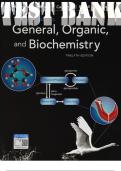
-
TEST BANK for Introduction to General, Organic and Biochemistry, 12th Edition, by Bettelheim, Brown, Campbell &Torres. (All 31 Chapters Complete Download)
- Other • 929 pages • 2024
-
- $29.49
- 2x sold
- + learn more
TEST BANK for Introduction to General, Organic and Biochemistry, 12th Edition, Frederick A. Bettelheim, William H. Brown, Mary K. Campbell, Shawn O. Farrell, Omar Torres. All 31 Chapters (Complete Dow nload). Table of Contents 1. Matter, Energy, and Measurement. 2. Atoms. 3. Chemical Bonds. 4. Chemical Reactions. 5. Gases, Liquids, and Solids. 6. Solutions and Colloids. 7. Reaction Rates and Chemical Equilibrium. 8. Acids and Bases. 9. Nuclear Chemistry. 10. Organic Chemistry. 11. Alkanes. 12. A...
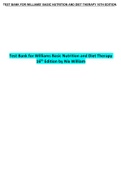
-
Test Bank for Williams Basic Nutrition and Diet Therapy 16th Edition by Nix William:TEST BANK FOR WILLIAMS’ BASIC NUTRITION AND DIET THERAPY 16TH EDITION: Updated A Plus Solution: (Chapter 1_23)
- Exam (elaborations) • 231 pages • 2023
-
- $11.00
- 3x sold
- + learn more
Promoting a health care service that improves diabetes management for the elderly in a community would assist in which of the following? a. Supporting the national health goals Healthy People 2020 b. Reducing hunger in a subset of the United States population c. Improving Medicare reimbursement claims d. Providing access to primary health care services ANS: A Healthy People 2020 has a wide influence and is the focus of the nation’s main objective to promote health and prevent disease. ...
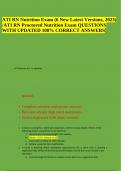
-
ATI RN Nutrition Exam (6 New Latest Versions, 2023) /ATI RN Proctored Nutrition Exam QUESTIONS WITH UPDATED 100% CORRECT ANSWERS.
- Exam (elaborations) • 145 pages • 2023
- Available in package deal
-
- $17.99
- 6x sold
- + learn more
ATI RN Nutrition Exam (6 New Latest Versions, 2023) /ATI RN Proctored Nutrition Exam QUESTIONS WITH UPDATED 100% CORRECT ANSWERS. ATI Nutrition test by spashnet spasnet • Complete solution and correct answers • Best and already high rated documents • Secure highscore with more versions 1. A nurse is caring for a client who expresses a desire to lose weight. Which of the following actions should the nurse take first? a. Recommend checking weight once weekly. b. Obtain a 24-hr di...
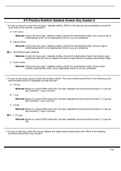
-
ATI Practice Nutrition Detailed Answer Key Graded A
- Exam (elaborations) • 42 pages • 2023
-
- $15.00
- 5x sold
- + learn more
1. A nurse is caring for a client who has type 1 diabetes mellitus. Which of the following recommendations should the nurse make to the client for a sweetener? A. Corn syrup Rationale: Clients who have type 1 diabetes mellitus should limit carbohydrate intake. Corn syrup is high in carbohydrates and is not an appropriate choice to use as a sweetener. B. Natural honey Rationale: Clients who have type 1 diabetes mellitus should limit carbohydrate intake. Honey is high in carbohydrates and is n...
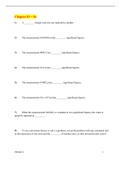
-
Test Bank for General, Organic, & Biological Chemistry, 5th Edition by Janice Smith
- Exam (elaborations) • 1119 pages • 2022
-
- $35.49
- 18x sold
- + learn more
Test Bank for General, Organic, & Biological Chemistry 5e 5th Edition by Janice Smith. ISBN-13: 2023 Full Chapters test bank included Chapter 1: Matter and Measurement Chapter 2: Atoms and the Periodic Table Chapter 3: Ionic Compounds Chapter 4: Covalent Compounds Chapter 5: Chemical Reactions Chapter 6: Energy Changes, Reaction Rates, and Equilibrium Chapter 7: Gases, Liquids, and Solids Chapter 8: Solutions Chapter 9: Acids and Bases Chapter 10: Nuclear Chemistry Chapter 11: In...
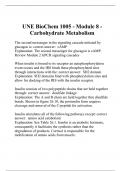
-
UNE BioChem 1005 - Module 8 - Carbohydrate Metabolism
- Exam (elaborations) • 16 pages • 2023
-
Available in package deal
-
- $11.49
- + learn more
The second messenger in the signaling cascade initiated by glucagon is: correct answer: cAMP Explanation: The second messenger for glucagon is cAMP. Review Module 2 GPCR signaling cascades When insulin is bound to its receptor an autophosphorylation event occurs and the IRS binds these phosphorylated sites through interactions with the: correct answer: SH2 domain Explanation: SH2 domains bind with phosphorylation sites and allow for docking of the IRS with the insulin receptor. Insulin...
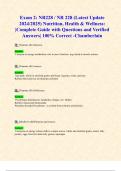
-
Exam 2: NR228 / NR 228 (Latest Update 2024/2025) Nutrition, Health & Wellness: |Complete Guide with Questions and Verified Answers| 100% Correct -Chamberlain
- Exam (elaborations) • 20 pages • 2024
-
Available in package deal
-
- $10.99
- 2x sold
- + learn more
Exam 2: NR228 / NR 228 (Latest Update 2024/2025) Nutrition, Health & Wellness: |Complete Guide with Questions and Verified Answers| 100% Correct -Chamberlain Q: Thiamine (B1) function: Coezyme in energy metabolism. role in nerve function- ing related to muscle actions. Q: Thiamine (B1) sources Answer: lean pork, whole or enriched grains and flours, legumes, seeds, and nuts Refined flour and rice are thiamine enriched Q: Thiamine (B1) Deficiency Answer: Psychologic distr...

How much did you already spend on Stuvia? Imagine there are plenty more of you out there paying for study notes, but this time YOU are the seller. Ka-ching! Discover all about earning on Stuvia


